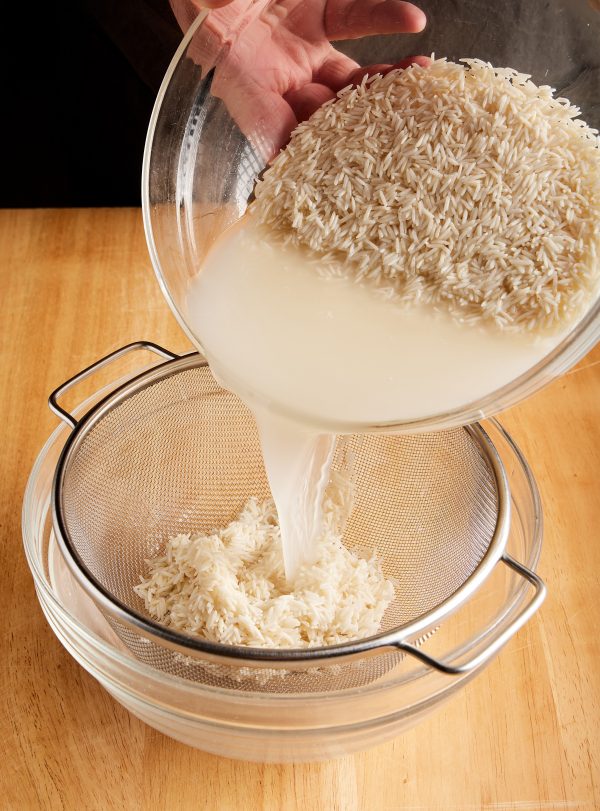
Recipes often call for soaking basmati rice before cooking it. We wondered why and whether it’s always necessary. To see, we cooked basmati on its own and with other ingredients (as in biryani). We found soaking is not necessary when cooking rice solo; doing so causes it to break and taste gluey. We do, however, rinse it first to remove excess starch. For basic basmati, rinse and drain 1½ cups white basmati rice. Combine with ½ teaspoon kosher salt and 2¼ cups water in a large saucepan. Bring to a boil over medium-high, then reduce to low, cover and cook until tender, 15 to 17 minutes. Let stand, off heat and covered, for 10 minutes, then fluff with a fork.
Cooking basmati rice with meat and vegetables was another matter. Unsoaked rice cooked unevenly, with some grains undercooked. Moisture released by other ingredients throws off the volume of cooking liquid, while acidic ingredients hinder liquid absorption. Soaking in salted water before cooking fixed this, partially hydrating the grains and ensuring even cooking. In our tests, soaked rice absorbed nearly a quarter of its weight. So in these recipes, we suggest a 30-minute soak in enough water to cover by 1 inch (seasoned with 1 tablespoon kosher salt per 2 cups rice).
The Main Market in Gulberg—one of 10 neighborhoods that make up the sprawling city of Lahore—unfolds across three concentric circles, each a choreographed chaos of motorbikes and cars and waiters carrying truck tire-sized stainless steel trays hoisted high and piled higher with bread and bowls of saucy chickpeas. Washing over it all, a white noise of thrumping engines, sizzling pans that saturate the air with savoriness, and from alcoved shops endless shouts of “Apka naan taiyaar hai!”
“Your naan is ready!”
The innermost circle caters to a younger crowd, shops serving ice cream, pizza-inspired paratha and “burgers” of griddled shredded chicken mixed 1:1 with mayonnaise and slathered onto crustless white bread with a fried egg. Venture outward, and the more traditional flavors of Pakistan reveal themselves. Karahi, a chicken stir-fry sauced in a savory-sweet reduction of tomatoes and chilies. And chapli kebabs, meaty patties seasoned with raucous amounts of chili flakes, cumin and whole coriander.
Wind your way through the alleys that bisect the ring roads, and the shops become denser and smaller. Seating is sparse, giving way to what Pakistanis call the drive-thru, but feels a closer cousin to a 1950s drive-in. Drivers stop pretty much anywhere and are swarmed by runners who relay their orders to nearby shops, then return just as quickly with food. Traffic snarls be damned, most people stay put and dine in their vehicles or perched on their motorbikes.
It was down one of these alleyways, just off Street 37, that I encountered my first Pakistani biryani, an impressively aromatic dish that to the uninformed—hand raised!—can present as a kitchen sink sort of affair. A riot of spices, vegetables, meat, rice, herbs, chilies, yogurt, sometimes dried fruit. Until you taste it. That’s when you realize how perfectly it encapsulates the soul of Pakistani cooking, how perfectly it teaches the core tenet of the nation’s cuisine: the power of layering.
OF CHARCOALS AND CLAY
It’s difficult to stand close to Mohammed Muzmil’s stainless steel food cart, named Daleem-e-Khas Matka Biryani. Tucked along the side of a narrow street and plastered with red and gold Coca-Cola signs with the words “Real Magic” written over glossy images of colorful bowls of rice, the cart’s main fixture is a long, shallow bed of blazing red coals egged on by a compact metal fan blowing into them from one side. Waves of intense heat wash off in all directions.
Behind the cart, a massive pile of urn-like clay pots, called matkas, inverted and stacked six high. It was quiet when I arrived a bit before lunch; I was lucky. Muzmil explained that closer to prime time, there could be a line down the street for his biryani, of which he prepares more than 100 portions a day. When his ingredients run out, the shop closes.
Named for the pot it is cooked in, Muzmil’s is a special variety of biryani, called matka biryani, or one-pot biryani. It’s a more rustic approach than classic biryani, he explains, which traditionally calls for its various ingredients to be partially cooked separately, then layered into a pot to finish cooking together. In matka biryani, everything goes in at once, though still layered, then the pot is sealed for cooking. The result, he assures me, is better because the ingredients season one another as they cook.
Intrigued, I order a large biryani, a portion that could easily feed three or four, and pay 800 rupees, or about $2.70. He grabs one of the clay pots and first adds bone-in chicken that has marinated in spices, green and red chilies, tomatoes, lemon and mint. Next, peeled potatoes, broth, a flurry of spices pinched from a masala dabba (the classic spice container of India and Pakistan), as well as chaat masala, a spicy-savory-sour seasoning blend. Finally, rice, tomato slices, oil and chili sauce.
The pot—now overflowing—is sealed tight with foil and nestled into the bed of coals. Soon, steam hisses from beneath the folded edges and the air fills with warm rice, savory chicken and spice. To serve, Muzmil peels back the foil and overturns the pot onto a platter, creating a mound of chicken and rice perfumed and stained yellow and red from turmeric and tomatoes.
It was amazing. The chicken was tender and browned, having seared slightly on the bottom of the pot while simultaneously steaming with the other ingredients. The rice was fluffy and intensely flavorful, rich with cumin, cardamom and chili. I initially thought the starch-on-starch combination of potatoes and rice would be too much, but it was perfect.
BIRYANI BASICS
But matka biryani isn’t the version most people eat. So for a lesson in the basics, I meet with Muneeze Khalid, who runs a cooking school for women in Lahore. The dish has Persian roots, likely dating to the Mughal era. Some think the word biryani even stems from birinj, the Persian word for rice. It’s almost certainly a relative of the classic pilaf, but with some important differences, including that unlike pilaf, biryani never is served as a side, always a main.
But since many ingredients between pilaf and biryani overlap, the more important difference is technique. Most pilaf is made by simmering rice and other ingredients in seasoned broth. But biryanis—of which innumerable varieties are made across the Indian subcontinent, mostly differentiated by how much and which meats and seasonings are used—always are layered and cooked slowly to allow the flavors to meld and play off one another in more subtle ways, Khalid assures me.
"The layering is the important part of getting each and every grain of rice to taste just right," she says. "If you just dump everything together, you will get porridge. Layering allows everything to steam and cook properly and blend flavors."
To demonstrate, she and Shahnaz Kausar—who learned to cook from Khalid’s grandmother 40 years ago and has cooked for the family ever since—prepare their biryani, a 30-ingredient affair that takes hours. And is worth every minute.
First, onions are browned in a momentous volume of ghee, turning tender and rich. Whole spices follow: bay leaves, black peppercorns, cloves, green and black cardamom, cinnamon sticks and cumin. Then garlic, ginger and chicken, just long enough to give it some color. More spices, this time ground, then tomatoes, yogurt and lemon juice. Next, yet more spices, this time a blend. More on that in a moment. Meanwhile, basmati rice is parcooked on the side. Finally, it’s time to assemble!
The biryani is built in a second large pot, starting with the chicken and the rich sauce it simmered in. Over that, a layer of cilantro, mint and lemons, then finally several inches of rice, plus a splash of saffron-tinged water, a few more lemon and tomato slices, a bit more broth. Covered, it cooks for about 30 minutes, the rice becoming fluffy and boldly seasoned.
The result, of course, is as delicious as it is beautiful.
ANOTHER LAYER
The physical layering of ingredients obviously is the heart of a great biryani. But there is another, less obvious form of layering going on that is just as important: the use of spices to create layers of flavor.
Much like cooks in India, Pakistani cooks lean heavily on spices. And they often use the same spices in multiple ways in the same dish. They add them in different forms, such as whole vs. ground, and at different times—at the start of cooking to bloom in the fat, then again at the middle and end of cooking. This is because adding different forms of a spice at different times allows the cook to coax different flavors from each instance.
All of the many biryanis I ate in Pakistan demonstrated this. Even Muzmil’s simpler matka biryani used the same cluster of spices three ways. First in the marinade for the chicken, then as individual spices added to the clay pot, and finally as a masala, or spice blend made from toasted ground versions of many of the same ingredients. The result is a depth and complexity of flavor impossible to accomplish with a simple dump-and-simmer approach.
For our own biryani, we combined the best of both styles we tasted. We loved the ease of matka biryani, but wanted the complexity Khalid and Kausar achieved by cooking the ingredients separately before combining them.
We found that the solution was to caramelize onions in ample ghee and oil, then set them aside. We then briefly cooked the chicken, potatoes and spices in the same pot on the stovetop before layering everything together and finishing the dish in the gentler heat of the oven.
In the process, we learned we could skip the step of parcooking the rice. Thanks to the layered cooking in a covered pot, which creates the perfect environment for steaming, we were able to simply soak the rice in water while prepping the remaining ingredients. Once layered with everything else, it cooked up perfectly fluffy and flavorful.
The result was a biryani built from delicious layers of flavor. Though we’re still not certain we’d eat it in our cars in traffic.
Related Recipes
January - February 2024

Sign up to receive texts
Successfully signed up to receive texts!
We'll only send our very best offers - Like a $15 store credit to start.
By entering your phone number and submitting this form, you consent to receive marketing text messages (such as promotion codes and cart reminders) from Christopher Kimball's Milk Street at the number provided, including messages sent by autodialer. Consent is not a condition of any purchase. Message and data rates may apply. Message frequency varies. You can unsubscribe at any time by replying STOP or clicking the unsubscribe link (where available) in one of our messages. View our Privacy Policy and Terms of Service.



